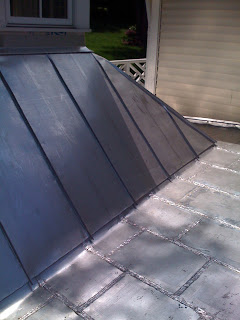

 Another one done; this job wasn't easy. We had brilliant sunshine last week and although it doesn't look it from the pictures the stainless is really shiny. So you get the sun from above and then the sun from below bouncing back at you. I think the inside of my nose got sunburned.
Another one done; this job wasn't easy. We had brilliant sunshine last week and although it doesn't look it from the pictures the stainless is really shiny. So you get the sun from above and then the sun from below bouncing back at you. I think the inside of my nose got sunburned. A few things about this roof:
First: this is the worst its ever going to look. There is a light varnish on the material that we remove from the perimeter of each sheet before soldering; thats why some look hazy. The weather will remove the rest in about a month.
Second: after about two years the roof will develop a uniform light gray patina and the solder lines (which stick out sorely) will all but disappear. After the patina develops all the little dents and tool marks will also disappear. If you want a roof like this for your house come visit me at www.lyonscontracting.com

The tool in the top picture is a soldering iron, an electric soldering iron. I have always used propane or acetylene irons; never again. This iron is from American Beauty Soldering Tools http://www.americanbeautytools.com/.
I had seen electric irons in a few places on the web, I always figured they were too weak. Think about it, what would be better than a loud, white hot, roaring flame blasting out of the handle holding the iron; I was wrong.
My new electric soldering iron is my new favorite tool.
First off its silent; my propane iron is so loud I that I cant hear myself think. Imagine working in your office with a running motorcycle parked next to your desk.
Second, it holds heat unbelievably well, I can fully solder three panels without having to pause to let the iron heat back up. With its constant and even heat I am able to make more consistent seams with faster production times. With my propane iron I was able to fully solder around forty panels in an eight hour period, with the American Beauty 550W electric iron I was averaging around sixty panels in the same eight hours. This tool paid for itself before lunchtime on the second day.
Third, it is a breeze to set up, all I need up on the roof is a heavy gauge extension cord. Just plug it in, set up your work area and in five minutes the iron is up to operating temperature. With propane or acetylene I need the tank, the hose, the ignitor, something to hold the tank and a nearby fire extinguisher. With the electric iron I don't have to worry about running out of gas, which always seems to happen at 5:45pm on the last two feet of seam to be soldered, that means coming back the next day and that costs money.
A special thanks to Mr. Virgil Brooks, he is the engineer at American Beauty Tools and has been a great resource. I have a prototype iron of his that I'm going to test out next month; can't wait to see what it can do.
American Beauty Soldering Tools 1-800-550-2510




